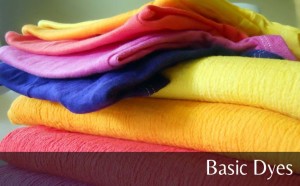
Dyes and pigments are two types of colorants that play an important role in various applications. One of the greatest beneficiaries of these colorants has been the textile industry. Varied hued fabrics and prints to suit the mood and the occasion are being made available through these colorants. However, every variety of dyes and the pigments have their own characteristics that make them suitable for certain fabric types as against others.
Let us note the attributes of basic dyes, direct dyes and pigments with respect to their suitability for cellulosic fibers. Basic dyes which are known for their intense and brilliant colors play a significant role in the textile industry when it comes to dyeing acrylic fibers. With regard to cotton they display poor light-fastness and hence the fabric colors fade in no time on exposure to light. If they need to be used on cotton, for example, when vibrant hues are needed on the cotton fibers; then they have to be mordanted with tannic acid. Cotton has to be initially treated with a mordant which develops a direct bond to the fiber and then acts as a medium for ensuring bonding of the dye. Because of the troublesome process involved these dyes are used only in dire situations for cotton. However, basic dyes are the best colorant form to lend brilliant hues to acrylic fiber. Acid red, acid black and many more are available in this category.
When you consider direct dyes they can lend bright hues to linen and cotton without needing the use of a mordant. However, they show poor wash-fastness and this dye requires after-treatment to enhance its wash-fastness. This treatment is known as cationic dye fixing. Other fibers which undergo direct dyeing include silk, rayon and wool.
As against the above dyes, pigments used in textiles offer greater color strength, high light-fastness and weather fastness besides offering bright hues. However, pigments for paint are one of the most widely used applications of pigments as compared to any other. Being insoluble substances, they have to be used along with binders so that they attach themselves to the substrate. Dyes on the other hand attach themselves to the substrate on which they are to be used.
Besides the textile industry, many of the dyes play a significant role in other applications too. Purple dye used as voter-identifiers during elections or used by sheep herders for marking their animals in the flock or fluorescent dyes used for highlighting human organs and cells during biological investigations are just to name some specific applications of dyes. ‘Tunable’ laser beams obtained from dye-based lasers have a wide use in medical field, spectroscopy, astronomical research and manufacturing.
Whatever be the significance and enormity of the applications, dyes and pigments have an equal place of importance in the colorant industry. Today, the focus of specialists in this field is more on developing newer formulations of dyes and pigments that will be eco-friendly and have better coloring, stability, flow attributes and use resources that are sustainable. These efforts are going to make the world of colors a definitely better place!